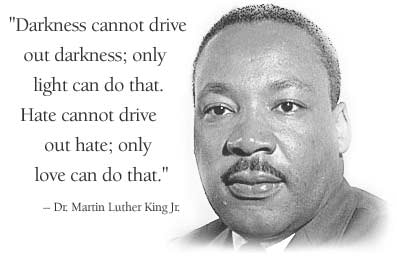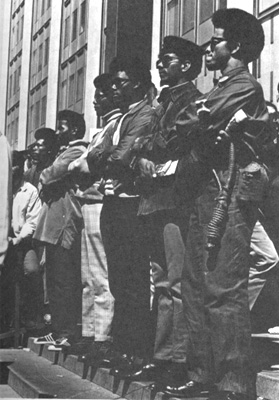Web Lecture #8
|
|
The Black Revolutionary Arts Movement
|
|

Lesson Overview
This
online lecture will discuss the Black Revolutionary Art Movement and the Civil
Rights and Black Revolutionary protests that preceded it. Leroi Jones, also
known as Imamu Amiri Baraka, was one of the major proponents of a revolutionary
approach to theater that began in urban Northern cities between 1963 and 1967.
The Black Revolutionary Arts Movement emphasized separatism, black consciousness,
community involvement, and new aesthetics for Black art. The plays that we
will be reading for class, Dutchman and The Slave, are examples
of this approach to playwriting.
Key Concepts

The
play A Raisin in the Sun was written in the 1950’s when many African
Americans were struggling for peaceful integration and acceptance into White
mainstream society. By the early nineteen sixties, the tactics of Black protest
had significantly.
The Civil Rights Movement was a series of peaceful protests whose major
figurehead was a Southern minister named Dr. Martin Luther King. The
movement was based in the South where  organizers
staged demonstrations and sit-ins to increase awareness about social inequalities
that were a result of segregation. On May 17, 1954 the Supreme Court of the
United States ruled, in Brown versus the Board
of Education, that separate by equal was unconstitutional. Despite
this legal action, African Americans remained restricted in their access to
housing, education, transportation, health care, and public gathering places
as a result of massive resistance by American citizens. Signs indicating "for
coloreds only" or "for whites only" were major symbol of continuing restrictive
practices. Railroad cars, water fountains, hotels, buses and neighborhoods
all remained segregated.
organizers
staged demonstrations and sit-ins to increase awareness about social inequalities
that were a result of segregation. On May 17, 1954 the Supreme Court of the
United States ruled, in Brown versus the Board
of Education, that separate by equal was unconstitutional. Despite
this legal action, African Americans remained restricted in their access to
housing, education, transportation, health care, and public gathering places
as a result of massive resistance by American citizens. Signs indicating "for
coloreds only" or "for whites only" were major symbol of continuing restrictive
practices. Railroad cars, water fountains, hotels, buses and neighborhoods
all remained segregated.
Violence
was prevalent. Major events in the struggle for Civil Rights included:
Snipers
and mobs frequently attacked Civil Rights activists. State and local police
agencies assisted politicians in repressing the movement. Both Blacks and Whites
participated in the public protests.
Martin
Luther King advocated for a strategy of non-violent protest in which demonstrators
would occupy a public place and refuse to leave. An example would be occupation
of a segregated lunch counter. Protesters would arrive at the restaurant and
ask to be served. When refused they would remain at the counter until police
were mobilized. The strategy of non-violent protest depended upon media coverage
to publicize the activities. Television was fairly new technology during this
time period. For many Americans it was the first time that they were able to
witness the violence that ensued as a result of peaceful protest for humanitarian
rights.
The culmination
of the Civil Rights movement was the Civil Rights Act of 1964 that outlawed
discrimination in public facilities, employment, and schools.
|
|
The
Black Panther Party for Self-Defense was one of the leading organizations
advocating Black Power. (Source: J.C. Albert and S.E. Albert, eds.,
The Sixties Papers [Praeger, 1984], 105)
|
At the
same time many urban youth in the North believed that non-violent protest was
ineffectual. These activists were responsible for the emergence of the Black
Power movement. Advocates of Black
Power movement were separatists who believed that equality could only
be achieved if African Americans formed their own cultural institutions. These
institutions celebrated African and African American political and cultural
practices. For example, Karamu House in Cleveland provided social and economic
support for urban families, supported African dance companies as a well as a
theater center, and taught young people the communal values of East African
life. Many Black Studies programs at colleges and universities are a direct
result of the activism of Black Power advocates.
One of
the most influential spokesperson for the Black Power movement was Malcolm
X. Working out of the Harlem community; he
encouraged
economic separatism and independence. He practiced Islam and encouraged his
followers to educate themselves about world politics. He thought that discipline
(religious, moral and educational) was the key to positive action on behalf
of the African American community. His all-Black organization was a threat to
White politicians and authority figures.
Some revolutionaries
advocated for armed resistance against the system of racial oppression. The
most influential of these organizations was the Black
Panther Party. The Party, founded by Huey Newton and Bobby Seale in
1966 promoted the idea of self-defense. They established community patrols and
affirmed the rights of Blacks to use violence to defend themselves. Many of
their headquarter sites were raided during the late nineteen sixties.
A new arts
movement emerged out of the protests and political activism of the late nineteen
fifties and nineteen sixties called the Black Revolutionary Arts Movement.
Leroi Jones (Amiri Baraka) and Ed Bullins are perhaps the most well known playwrights
to work within this aesthetic.
The
Black Revolutionary Arts Movement emphasized:
1) Separatism
and Revolutionary Action
2) Black
Consciousness
3) Community
Involvement.
4) New
Aesthetics and Innovations in Form and Structure
Separatism
and Revolutionary Action
Plays written
by Black Revolutionary playwrights encouraged African Americans to work outside
of White institutions and White cultural formats and to write from their own
experiences. Theater was to encourage revolutionary thought and to incite strong
political action. Audiences were expected to leave the theater with new understandings
about the politics of race in America.
Black
Consciousness
Black identity
was celebrated in the Black Revolutionary plays. Thematically the plays portrayed
the experiences of slavery, the cultures of Africa and the struggle against
White oppression.
Community
Involvement
African
American community members were encouraged to participate in the play productions
as amateurs, activists and audience members. The theater events were dialogues
that included audience response and involved audiences in the experience of
the theater. Some plays used call and response exchanges, environmental smells
and sounds, and spontaneous speeches to encourage participation.
New
Aesthetics and Innovations in Form and Structure
The Black
Revolutionary playwrights sought to explode familiar forms of theatrical narrative.
Building upon strategies introduced by Antonin Artaud and his Theater
of Cruelty they wanted to confront audiences with images drawn from the
Black experience. Sometimes they appropriated formats based upon the African
American church or communal ceremonies characteristic of African circle dances.
Images and scenarios depicted violence and symbolic overthrow of antagonists.
Cultural performance modes such as jazz music and word poetry determined the
structure of some of the plays The goal was to encourage audiences and performers
to create a theatrical dialogue that differed from Euro-American models. Most
of the theater was expressionistic rather than realistic.
Leroi Jones
wrote an Essay about the Black Revolutionary Theatre that states:
The
Revolutionary Theatre should force change…The Revolutionary Theatre must
EXPOSE!…White men will cower before this theater because it hates them…
The Revolutionary Theatre must teach them their deaths. The Revolutionary
Theatre must Accuse and Attack anything that can be accused and attacked.
It must Accuse and Attack because it is a theatre of Victims….It must isolate
the ritual and historical cycles of reality…when the final curtain goes
down brains are splattered over the seats and the floor, and bleeding nuns
must wire SOS’s to Belgians with gold teeth…Americans will hate the Revolutionary
Theatre because it will be out to destroy them and whatever they believe
is real. American cops will try to close the theatres where such nakedness
of the human spirit is paraded. American producers will say the revolutionary
plays are filth. ..We want actual explosions and actual brutality…The Revolutionary
Theatre will soon begin to be peopled with new kinds of heroes—not the weak
Hamlets debating whether or not they are ready to die for what’s on their
minds, but men and women (and minds) digging out from under a thousand years
of "high art" and weak-faced dalliance.(excerpted from Leroi Jones "The
Revolutionary Theatre," Liberator 5, no.7 (1965) 5.)
Leroi
Jones Biography
Leroi Jones
was raised in a middle class family in Newark New Jersey. Born in 1934, he graduated
from Howard University in Washington D.C. and moved to the Greenwich Village
section of New York in the late nineteen fifties. While there, he became immersed
in the avante garde arts scene that included figures like musician John Cage,
choreographer Merce Cunningham, and poets like Alan Ginsberg and Robert Duncan.
These white artists were experimenting with art forms and structures and staging
conceptual events like "happenings" and outdoor
performance spectacles.
Between
1958 and 1963, Jones married a White woman named Hettie Cohen and edited a literary
magazine with her called The Moderns. Their work was strongly influenced
by beat poetry, conceptual jazz artistry socialist political thought.
Dutchman,
one of the plays that we will be reading for class, was presented at the Cherry
Lane Theater in Greenwich Village in 1964.
In 1965,
after the assassination of Malcolm X, Jones divorced his wife, moved to Harlem,
severed ties with his White associates, and immersed himself in the Black Revolutionary
Arts Movement. He remarried, this time to a Black woman named Sylvia Robinson,
and in 1967 changed his name to Amiri (Prince) Baraka (the Blessed One). He
worked with political organizations and supported Black playwrights like Ed
Bullins, Larry Neal, and Ron Milner.The play The Slave was written in
1965, just before his move to Harlem.
Baraka/Jones
later moved to Newark NJ and supported the mayoral campaign of Ken Gibson. He
founded several theater companies, taught as a Visiting Professor at Yale and
George Washington University, and later, as a full Professor at SUNY, Stony
Brook.
Dutchman
and The Slave
Dutchman
is "A ritualized reenactment of a script written by history and an innately
corrupt White society—a script in which both blacks and whites are captive cactros
riding a doomed ship." (Sanders, Leslie Catherine. The Development of Black
Theater in America. Baton Rouge: Louisiana State University Press, 120)
Jones uses
ritual and symbolic imagery to communicate his message about the mendacity of
American society. Questions to consider for our in-class discussion are:
1)
What does the title of the play refer to?
2)
How do the characters in the two plays move from a state of innocence to a
state of political awareness?
3)
How is language used by Jones to illustrate the social consciousness of the
characters?
4)
What allegories and symbolic imagery does Jones use highlight the social relationships?
Be prepared
to talk about these concepts at our next class meeting.


 organizers
staged demonstrations and sit-ins to increase awareness about social inequalities
that were a result of segregation. On May 17, 1954 the Supreme Court of the
United States ruled, in
organizers
staged demonstrations and sit-ins to increase awareness about social inequalities
that were a result of segregation. On May 17, 1954 the Supreme Court of the
United States ruled, in 
